Paul Westhead's Loyola Maramount Fast Break and Transition Offense System
The "Loyola Marymount" break was developed by Paul Westhead. Coach Westhead developed a reputation as a free thinker throughout his coaching career. While at LaSalle College in the 70s and 80s, his "0" defense gained widespread notoriety when it was learned that the defense was named because one defender was asked to play no (zero) defense. All he was expected to do was anticipate a steal or a shot and take off down the floor to the offensive end and look for the ball.
In the early 80s, he moved to Loyola Marymount University, where he developed a transition offense system that led to his teams being the highest scoring team in NCAA history.
As I mentioned before, it's not the pattern that makes the play, it is the philosophy. Coach Westhead's philosophy was that he wanted to get a shot up in less than 7 seconds. He tried to create such a frenetic pace, that the other team would just give up. Often they did, out of utter exhaustion.
I am not going to recommend to you that you adapt a similar philosophy. But, to enact that philosophy, Coach Westhead developed a break where its beauty was its simplicity. It featured numbered lanes and specific early cuts to follow ball reversal. By the time the ball was reversed, it had to be up at the basket. It is that simplicity that allows it to fit in with the half court offenses in this transition offense system.
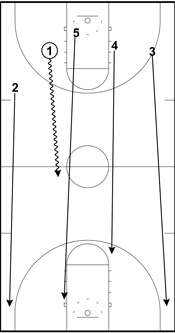
The LMU break, like the Carolina Break, is a numbered break.
2 runs to the right corner.
3 runs to the left corner.
5 runs to the right block.
4 trails and goes to the left elbow.
1 advances the ball on the dribble as quickly as he can and tests the drive to the middle.
The first option all players have when they receive a pass is to shoot.
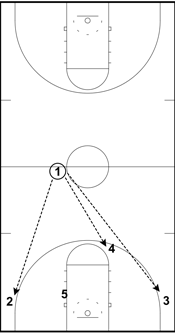
1 can headman the ball to either 2, 3, or 4.
The player's first option is to shoot.
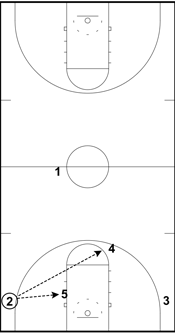
If the ball is headmanned to the corner and he does not take a shot, he can look in to 5 in the low post or to 4 as the trailer.
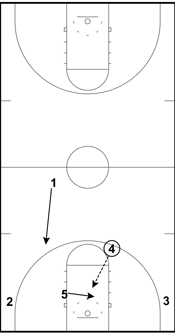
If the pass goes to 4, it has changed sides of the court. Anytime the ball changes sides, the 5 man cuts block to block.
1 fills the wing.
4 looks to pass into 5 as he cuts.
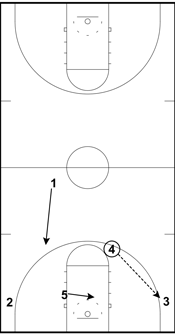
4 can swing the ball to 3.
5 cuts block to block.
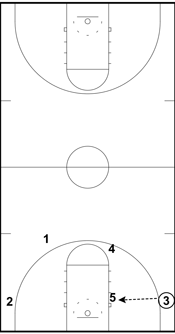
If 3 does not shoot, he looks into 5 on the block.
Related Pages & Helpful Resources
Fast Break Basketball Offense - Carolina Secondary Break
Fast Break Basketball Offense - Phoenix Suns
Competitive One on One Fast Break Drills - 1v1 Attack
5 on 3 + 2 - Fast Break Drills
Want to learn how to build your fast break and transition offense step by step?
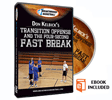
|
Don Kelbick's Transition Offense and the Four-Second Fast Break This DVD shows you how to build your fast break and transition offense step-by-step, so you can easily teach it during practice. It will also show you how to seamlessly transition into your half court offense to keep the defense scrambling. As every great defensive coach will tell you, they play their best defense when they have their 5 players back. This DVD will show you how to take advantage of the defense when they're not set and currently in transition. It also includes many fast break and transition drills that build mentality, aggressiveness, decision-making, and basketball skills. This DVD is 110 minutes long and neatly organized ... (more info) |
FREE BONUS PDF
10 Easy Transition Offense Drills
What do you think? Let us know by leaving your comments, suggestions, and questions...
|
||||||||||||||||||||||||||||||||



 Facebook (145k Followers)
Facebook (145k Followers) YouTube (152k Subscribers)
YouTube (152k Subscribers) Twitter (33k Followers)
Twitter (33k Followers) Q&A Forum
Q&A Forum Podcasts
Podcasts